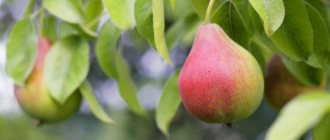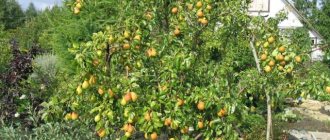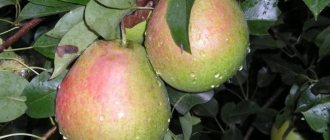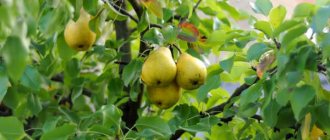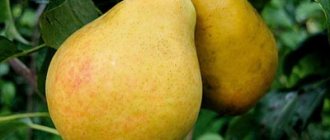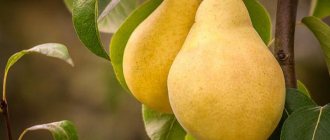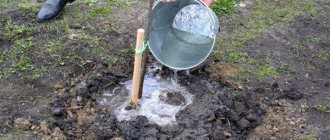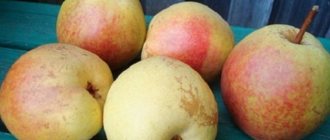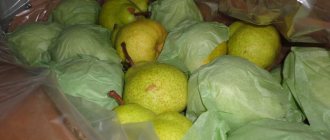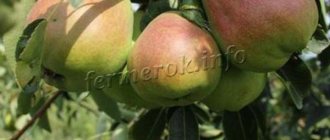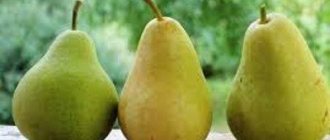Pear Fun.
Description of the variety
Pear Zabava is included in the group of varieties of autumn ripening. The variety appeared recently and has not yet been included in the State Register.
Characteristics of wood
The trees are medium-sized and can reach 5 meters in height. The crown is wide, moderately dense, and has the shape of a pyramid. The trunk and main branches are covered with dark brown bark. The foliage is large, green, and oval in shape.
Description of fruits
Pears are medium in size and reach a weight of 120-160 grams. The fruits have a standard, slightly expanded shape. Ripe pears have a beautiful, golden yellow color. Most of the fruit is covered with a light reddish blush.
Pears taste sweet, buttery, with a pleasant sourness.
Pear Fun.
Optimal growing conditions
Pear is a fruit crop that bears fruits of the same name. This fruit tree is grown in summer cottages and garden plots, taking into account its characteristics. Pear varieties are mainly zoned for climatic zones, since the crop is sensitive to frost and drought. Zabava pear is characterized as a variety with high adaptive qualities and increased frost resistance.
Zabava pear was bred as an autumn variety by Belarusian breeders. The popular pear varieties Lyubimitsa Klappa and Aleksandrovka were taken as a basis. The mixing of the qualities of the two varieties has led to the fact that the Zabava pear has spread among gardeners specializing in growing pear trees due to its excellent taste characteristics and stable yield indicators. Many gardeners choose the Zabava pear variety based on the photo and description of the variety. With its distinctive features, the Zabava pear catches your eye.
The tree attracts attention, first of all, with its neat appearance, as well as with its fruits, which have a regular pear shape:
- Tree. With an average degree of foliage, Zabava has a pyramidal-shaped crown. Shoot formation is characterized as average, which helps maintain the compact size of the bush. The trunk of an adult tree is thick, with flaky bark.
- Fruit. Pears have a rounded shape with an elongated upper part. Their average weight is 150 - 160 g. When fully ripe, they acquire a honey-yellow hue with redness on one of the sides. The structure of pears is granular, with sap.
Sweet with a slight sourness.
Increased, with fluid flow above average.
Tendency to storage
Due to their thick skin, the fruits can be stored for a long time and do not show a tendency to crack.
Zabava pear is zoned for cultivation in Ukraine, Belarus, Moldova, and North-West Russia.
Pear Zabava has increased adaptive properties. This quality was the goal of crossing parent varieties. Breeders managed to achieve good results while maintaining excellent taste characteristics.
When assessing frost resistance, the regionalization of the variety is taken into account. The behavior of trees when grown in regions with harsh winters has not been studied enough. It is known that the Zabava pear tolerates frosts well down to –15 °C. The trees do not require watering and can tolerate short periods of drought without loss.
Pollinators
Zabava pear is pollinated by neighboring crops. To do this, it is recommended to plant the following varieties nearby: Osennyaya Lyubimitsa, Naryadnaya Efimova. Flowering begins in May or early June. At the same time, the flowering dates of the Zabava pear and pollinator varieties must completely coincide.
Productivity
The yield indicator is high, while the Zabava pear bears fruit equally stably both in industrial cultivation and in private gardens.
Fruiting begins in the 5th - 6th year after planting the seedlings. Volumes are increasing every year. From one medium-sized adult bush, up to 70 kg of fruits are collected.
Application area
The dense skin allows the fruit to be subjected to long-term transportation. Pears are stored without signs of cracking. They are used fresh for making compotes and jams. Pear Zabava is also suitable for the classic dessert “Pears Blanched in Syrup”, as it retains its shape even after heat treatment.
Among the advantages of pear trees of the Zabava variety are:
- high yield rates;
- stability of fruiting;
- resistance to common diseases;
- moderation of growth, which makes it easier to process trees.
The disadvantage of this variety is that the behavior of trees at extremely low temperatures remains unknown.
Landing rules
The Zabava pear variety is grown in summer cottages. It is taken into account that an adult tree can grow in one place for more than 5 years. For full development, the pear needs an area free from planting, formed taking into account the characteristics of the crop.
Recommended timing
For regions with a warm climate, choose any period for planting seedlings: spring or autumn. In areas where the possibility of early frosts is high, it is recommended to plant pears in the spring.
For a tree, choose a place that meets several requirements:
- full access to sunlight, without obstacles in the form of tall buildings or neighboring trees with wide crowns;
- the course of groundwater should be as deep as possible, at least 2.5 m;
- The Zabava pear needs additional pollination, so a plot in the neighborhood is being cleared for planting a pollinator variety.
Gardeners prefer to plant 1-2 year old pear seedlings. The height of the young tree should be 80 - 85 cm. When choosing, carefully inspect the root system: it should not have damage, dry or rotting places.
Dry roots are soaked for 24 hours before planting. Use warm water or a solution to stimulate further root growth.
Landing algorithm
Preparations for planting begin in advance. In 2 - 3 weeks, dig up the selected area, fertilize with organic compounds if necessary. The hole is prepared and covered with protective material.
When disembarking directly, take into account the order of steps:
- The planting hole is dug again, it is prepared 10 cm deeper than necessary when the roots are completely buried.
- The top layer of soil is removed and set aside separately. The bottom layer is mixed with sand to make it loose and fertilized with compost if necessary.
- The top layer, removed in advance, is placed on the bottom of the dug hole, then the tree is placed in the center.
- To support the first stage of adaptation, a peg is placed nearby.
- After straightening the roots, cover the sides with soil, preventing the formation of air pockets.
- After complete falling asleep, the earth is compacted and a tree trunk circle is created.
The first watering is carried out along the trunk circle with warm water at the rate of 5 to 10 liters per tree. Before watering, the seedling is tied to a peg with a nylon rope. The need for tying disappears when the trunk becomes strong and dense.
Aftercare
Pear trees do not need special attention. Watering is carried out as the top layer of soil dries. When caring, follow the basic rules:
- Trimming. The tree is pruned after the snow melts, before the buds swell. The main task of pruning is to remove shoots that grow inside the crown, which means they will impede air circulation.
- Feeding. In spring, the soil is fertilized with nitrogen-containing mixtures. In the summer, after fruit formation, phosphates and potassium mixtures are added. Organic compounds are used for autumn feeding.
- Loosening. This agrotechnical technique is important for pears as a way to enhance the development of the root system. Air access makes the soil looser, which has a positive effect on root growth. Loosening is carried out after each heavy rainfall.
- Preparing for winter. Young trees are covered with burlap or agrofibre for the winter. Mature trees do not provide shelter. The tree trunk circle is mulched with pine needles and larch bark. This material allows you to retain heat and prevents the root system from freezing in winter.
- Protection from rodents. After harvesting, before the onset of frost, the trunks are whitewashed with lime. In addition, where rodents become frequent guests, barrier nets are installed.
We invite you to familiarize yourself with first grade wheat flour
The Zabava pear variety has increased resistance to diseases, but can be susceptible to bacterial infections if care rules are not followed. Scab and bacterial cancer are dangerous. To prevent diseases, it is recommended to regularly treat trees with preparations that contain copper.
Pests that take root on pears are aphids, codling moths and mites. The fight against insects begins with prevention: installing pheromone traps on trees in the spring. When pests invade, they are treated with insecticides.
Conclusion
Pear Zabava is a variety that has been successfully distributed throughout the regions of North-West Russia. With proper care, pear trees delight gardeners with a stable harvest. Pears have excellent taste characteristics.
Reviews
Pear Zabava is a bright representative of fertile autumn varieties with high yield. Read about the characteristics of the variety and the technique of growing pears in this review.
The variety was obtained at the Institute of Fruit Growing of the National Academy of Sciences of Belarus back in the Soviet period. The fun was bred by crossing the extremely popular variety Lyubimitsa Klappa with Aleksandrovka. From Klapp's Lyubimitsa the new tree received good frost resistance, and from the Aleksandrovka variety it received resistance to fungal diseases, including scab.
Zababova is grown in Belarus, Moldova, Ukraine, the Baltic States, Central Asia and in Russia to the North-Western region.
The pear is medium in size, despite the tallness of the parent varieties. It retains winter hardiness, so varieties less resistant to frost can be grafted onto it. In the first 2 years, the pear reaches its maximum height, and then grows its crown with lateral shoots.
Pear is a whimsical tree, but rowan is not. That's why gardeners came up with the idea of grafting pears onto rowan trees! As a result, pears grow on rowan trees, but their taste changes: they become less juicy and sweet and acquire some tartness characteristic of rowan berries.
Characteristics of the variety:
- crown: pyramidal, not very dense, medium-sized;
- shoots: thick, long, straight, dark brown;
- foliage: average, leaf size increases with age of the pear;
- fruits: about 120–140 g (average), but can reach 160–170 g;
- pear shape: regular broad pear-shaped;
- peel: glossy, rough;
- peel color: brown-yellow with blush, slightly spotted, green at technical maturity;
- pulp: milky white, tastes sweet with slight sourness, juicy, dense, medium aroma;
- tasting rating of the variety: 4.6 points out of 5.
Pear Zabava needs pollinators. For this purpose, the varieties Lyubimitsa osennyaya, Naryadnaya Efimova or Bere Loshitskaya are planted nearby. The pear begins to bear fruit in the 5th–6th year of development. Fruiting is stable, increasing every year as the crown develops. The yield of mature trees is 20 t/ha. The average life expectancy is about 50 years.
Growing conditions
- spots and sagging on the trunk and skeletal branches;
- swelling and traces of rot on the main roots.
Landing rules
Reviews
Tatiana
Tver
I planted this pear in the garden about 10 years ago. The harvest had to wait a long time and in the first years it was quite modest. The fruits themselves are very tasty and are well suited for making jam and compotes.
Nicole
Moscow
Cute small fruits are very tasty. But all sorts of codling moths really love the fruits of Zabava, we have to spray it twice a season, sometimes more often.
Anatoly
Ryazan
The variety is not bad, but the tree often gets sick. To ensure that the quality of the fruit does not suffer, you have to spray it several times during the summer, and since the pear is quite tall, this is quite difficult to do.
Pear Fun
A fast-growing variety of pear, which is distinguished by a regular and large amount of fruit harvest, excellent quality summer ripening time.
Zabava pear is a variety of pear that ripens in autumn, it is medium-winter-hardy, its yield can reach up to twenty tons/ha if it is planted according to a 6x4 meter planting pattern on a seed rootstock. The tree itself is medium in height, its crown is also medium dense, and is broadly pyramidal in shape. The type of fruiting is mixed, however, despite this, the tree bears fruit regularly.
In addition, the tree is moderately resistant to scab, and is also relatively resistant to any bacterial diseases. Absolutely all fruits of this variety are of medium size (approximately from 120 to 140 grams), they have a wide pear-shaped shape. The main color of the fruit is yellowish-green, but its outer color is brownish-red in the form of a single-color blush. The skin of the fruit itself is smooth and shiny. Also the skin is dry and slightly rusty. The pulp of the fruit is white, it is quite juicy and oily, has a pleasant sweetish-sour taste, which has a medium aroma. The fruit has a tasting score of 4.6 points. Terms of use from September to October.
Zabava pear will germinate well on any fertile and moist soil, even on heavy soils and in areas that are located near groundwater. Despite the fact that the pear has practically no preferences for soil, of course, fertile soil that is also rich in humus will have the best effect on it. It is also worth noting that Pear Zabava consumes a large amount of potassium, as well as nitrogen, thus it will respond well to the additional addition of these fertilizers. The last thing this variety needs is phosphorus. The difference between this pear variety and the others: minimal chemical. protection of trees, the tree is early-fruiting and regularly produces crops, the fruits are highly marketable.
When purchasing from our garden center, consultants will provide complete information on planting and caring for seedlings. If boarding yourself is difficult, you can order a boarding service from us.
Landing
In order for the seedling to strengthen well and begin to bear fruit sooner, it is necessary to choose the right site and prepare the planting hole. Recommendations for planting zabava pears can be found in the articles selected below.
How to plant a pear tree correctly
At what distance to plant pears?
How to choose pear seedlings
How to replant a pear
Care
In the first years, the young tree needs good care. By clicking on the links below, you can find useful information and tips on growing Zabava pears.
How to care for a pear Pruning a pear Pruning a columnar pear Treating a pear from diseases and pests Feeding a pear How to water a pear
Planting and caring for pears
Growing pears is usually easy even for a novice gardener. But before you start doing this, you should familiarize yourself with some rules that you need to adhere to.
The first important parameter is the size of the pear. A full-size tree can reach a height of 12 m, and the diameter of the crown can be up to 5 m, so you will need a fairly large area in which to plant and further develop the tree. The pear tree requires a sunny area. Be sure to choose a location that will provide the tree with at least 6 to 8 hours of sunlight per day.
The soil should be loose and moderately moist in order to ensure good development of the root system. If it often rains in your region, planting is carried out so that water does not constantly stagnate on the site. The soil should also be permeable to air, which means it should be loamy or sandy. It should be free of weeds and have an acidity level of around 6.5 pH.
Landing dates
In places with a warm, mild climate, pears can be planted in early spring or autumn. In northern regions, spring planting is preferable. Over the summer, the tree will have time to take root well and prepare for winter.
Rules and landing scheme
When planting, be sure to plant at least two varieties of pear trees. The Zabava variety will need a pollinator in order to provide you with a harvest. Make sure the varieties are compatible with each other.
Planting step by step is as follows:
- Before planting, soak the pear roots in a large container of water for 1-2 hours to prevent them from drying out while digging the hole. Do not keep the tree in water for more than 6 hours.
- Dig a hole that is 5–10 cm larger than the tree's root system. This will help the roots straighten and move freely to their new location. Set the top layer of soil aside; you will need it when you prepare the planting hole. This soil will need to be laid on its bottom.
- Roots grow best in loose soil, so mix sand into the topsoil if you have heavy soil.
- Use rotted manure or garden compost as fertilizer. Its mass is 1/3 of the total mass of the pit soil.
- Place the removed top layer of soil on the bottom. Cover it with prepared organic fertilizers and fill it with soil.
- Place the tree in the hole and add soil.
- To avoid air pockets, gently compact the soil around the roots.
- Leave a lip around the edge of the planting hole to facilitate watering. This will prevent water from flowing out of the hole.
Video: planting a pear seedling
Watering and fertilizing
Pear trees generally require minimal care and, once planted, only require periodic watering, fertilizing, and crown shaping. When watering, it is important to remember that the needs of a pear tree depend on its age. A recently planted young tree has not yet developed a root system and needs watering 2-3 times a week.
The area close to the trunk should be watered. As the roots grow, they straighten, and then the line to which watering is carried out should be equal to the diameter of the crown. Water a mature tree once a week. When doing this, take into account the condition of the soil. Clay retains moisture well, which means you need to water less often. But sand, on the contrary, removes it too quickly, so this soil is watered 2 times a week.
Pruning and crown formation
Pruning a pear tree begins in late winter, before the buds begin to swell. Early pruning may stimulate excessive vegetative growth. To prevent injury, the operation is performed before the first buds appear, lubricating the cut sites with a disinfectant solution.
Shaping a pear tree
For mature trees, pruning is possible in the summer, but no later than July. The young tree is cut at the top at a height of 1 m above the ground. This will ensure good development of the side branches and shorten the trunk so that it is convenient to harvest.
If there are many branches on the pear tree, remove those that are less than 50 cm from the ground and those that deviate less than 60 degrees to the side. This also ensures good air circulation around the branches and helps prevent disease.
Video: pruning pears in spring
Whitewash
Whitewashing trees is designed to protect them from external influences. Thus, bright sunlight and frost in winter can lead to cracking of the bark. The whitewash should protect them from this.
Diseases and pests
The variety has average resistance to fungal diseases and therefore it is very important to regularly carry out preventive measures. Useful materials and recommendations for protecting the Zabava pear tree can be found by clicking on the links below.
Dangerous Pear Pests
Pears often suffer from pests, they affect the leaves, bark and fruits.
In this article, we have selected 11 of the most harmful insects that harm pear trees, and also ways to destroy them.
Diseases of pear trees
To get what they cherish, gardeners have to work hard, and the reason for this is pear diseases.
Read about 19 common pear diseases and how to combat them.
Advantages and disadvantages of the variety
- Advantages of the Zabava variety:
- intensive growth;
- high productivity;
- stable fruiting;
- good frost resistance;
- resistance to scab and other diseases, as well as to the codling moth.
- Disadvantages of the variety:
- low preservation of fruits - no more than 4 weeks;
- insufficient research into disease resistance.
The Zabava variety is relatively young and has so far been tested only in some regions, mostly in Belarus. Therefore, the main disadvantage of the Zabava pear can be attributed to its little-studied winter hardiness in the conditions of central Russia.
But in addition, the Zabava variety also has specific positive qualities that enable it to be noticed by amateur gardeners for cultivation in areas near the house:
- short stature makes woodworking and harvesting easier;
- excellent fruit taste;
- amazing productivity of the Zabava variety in an individual garden.
